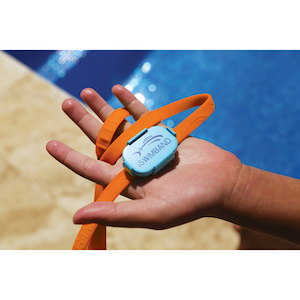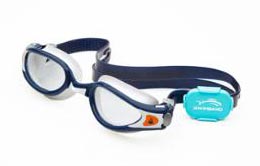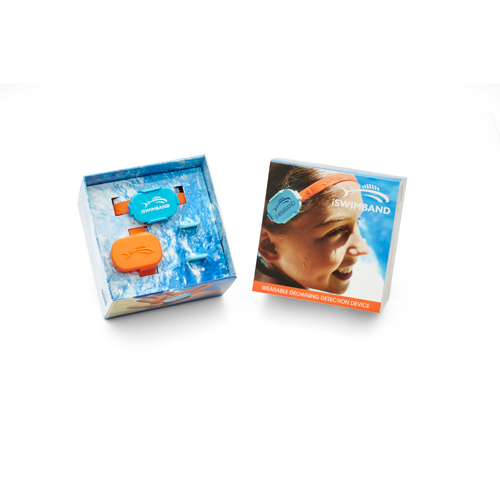 This review comes with a stern warning: while the iSwimband can be a useful tool for helping you keep an eye on the kids as they enjoy some pool time, it in no way replaces the need for adult supervision, and standard precautions, that are to be used at all times. That said, this app-based accessory is a great addition to keep parents who are extra vigilant on top of the kids’ activities in water.
This review comes with a stern warning: while the iSwimband can be a useful tool for helping you keep an eye on the kids as they enjoy some pool time, it in no way replaces the need for adult supervision, and standard precautions, that are to be used at all times. That said, this app-based accessory is a great addition to keep parents who are extra vigilant on top of the kids’ activities in water.
What is it?
The iSwimband is a band that can be worn around your child’s head or around a toddler’s wrist, then communicates via Bluetooth with a connected smartphone to provide warning alerts if the band (i.e. the child) has either been underwater for too long (based on a time you set) or if a toddler has entered the water altogether when he’s not supposed to.
Sure, any good parent will have his eyes on the kids 24/7 when they are in or near water. That’s a given. But let’s face it: sometimes accidents happen. Maybe something happens to your skilled swimmer underwater and you don’t realize that he’s been underwater a few critical seconds longer than he should be; or you turn your head for a split second—just enough time for your toddler to head toward the swimming pool. Chances are, parents and caregivers will react immediately. But having a blaring alert on your phone can also help warn others around that something is wrong, and warn you a critical few seconds earlier than you might otherwise see that something is amiss.
 How it works
How it works
Pairing the unit with your smartphone (iOS or Android) is simple: download the app, then shake the device to turn it on, and enter or confirm the serial number. At first, I thought the unit was defective, until I realized that you really need to shake it vigorously to activate it. I’d often have to try multiple times before it woke up.
Make sure to permit notifications from the device, which you can do in the Settings menu of your phone. In iPhones, it’s under Notification Centre and in Android devices, it’s under Application and Device Manager.
You can place it inside the bright orange rubber band and on a toddler’s wrist, into the included clip that attaches to the larger head band for older kids, or directly to a pair of swim goggles. Use the included clasps to tighten it and ensure it fits comfortably and securely.
When you open the app, you’re greeted with a disclaimer that reinforces that the system is meant as a supplementary form of monitoring a child in the water, not a replacement, and that it is to be used “to assist responsible adults supervising monitored persons in or near the water.” In other words, the iSwimband is not, by any means, meant to replace proper supervision.
Once you fully understand that, it’s time to get monitoring!
Using the iSwimband
Before you proceed, it’s wise to use the test option to confirm that your phone’s volume is high enough, and that it isn’t in silent mode. You’ll hear the loud, blaring sound, almost like a fire alarm, that clearly screams danger. Once you’re happy with the volume level, click “accept.”
As noted, you really need to shake the unit quite vigorously to turn it on. You’ll see a tiny red LED flash from inside to confirm, and the connected unit will pop up in the app. I named mine “Patrick” for my son, and added a photo of him for identification purposes. You can connect up to eight iSwimbands to the app if you have, or are monitoring, several kids.
 You can select from non-swimmer or swimmer—the former should only be used with toddlers wearing the band around their wrists, and the latter only as a headband or attached to goggles. (The reason being that toddlers can easily remove the headband whereas the wristband isn’t so easy to take off.) If you set it to non-swimmer, which I did for my 3.5-year-old, you’ll automatically get a red alert once the band is submerged for more than five seconds. For swimmers, you can allow a submersion time limit from 10 seconds up to a full minute for experienced swimmers.
You can select from non-swimmer or swimmer—the former should only be used with toddlers wearing the band around their wrists, and the latter only as a headband or attached to goggles. (The reason being that toddlers can easily remove the headband whereas the wristband isn’t so easy to take off.) If you set it to non-swimmer, which I did for my 3.5-year-old, you’ll automatically get a red alert once the band is submerged for more than five seconds. For swimmers, you can allow a submersion time limit from 10 seconds up to a full minute for experienced swimmers.
Oddly, the manual and the app don’t quite jive: the manual suggests that there’s an option for an “immediate” setting to alert whenever even a swimmer enters the water. But in the app, I could find no such option. That may, however, be a reflection of new app updates that removed this setting. The app also shows the ability to set both a warning and a red alert—the version of the app I downloaded (firmware 1.0) only show red alerts.
At the top of the screen, you’ll see a green dot, yellow dot, and red dot with numbers beside each, indicating how many swimmers you have in each stage. If there’s one in red alert, it will flash with the warning, and indicate who is in need of attention. This is great for daycares that might want an extra measure of precaution while taking multiple kids out to the pool on a hot summer day.
It’s a good idea to keep a clear line of sight between your phone and the band, which would be advisable anyway if your kids are near water. The band will alert you if your phone moves out of range, though, which is another good precaution to ensure they are always in sync. I tried it out with my son in a full bathtub (being watched by his father) and was able to receive warnings two levels down in the basement. You can set up secondary monitoring devices via WiFi so that mom’s phone might be connected from out on the deck, for example, while dad’s device is also connected from inside so he gets alerts, too.
A great feature is that if you haven’t used the band in a while (say through the winter), it’ll remind you of that and ask if you want to adjust settings. This can be useful if your child has moved up a level in his swimming classes, for example, and can now remain under water for longer periods of time.
While the idea is to use the band in indoor or outdoor pools or at the beach, it can also be a smart tool at home for bath time. While it’s advised not to initially test the device in a body of water that’s less than five gallons, you could place one on your toddler at bath time to receive a warning if he jumps into the bathtub while you run out of the room to grab a towel.
 You can see battery life in the app, but note that the battery is not user-replaceable or rechargeable. iSwimband says, however, that it offers “hundreds of hours” of active use, estimated to be about a year’s worth of monitoring based on an average of four hours of active time every other day. If you plan to use it more than that, expect to have to replace the unit. That said, that’s quite a bit of swimming. The most important thing is that the app will warn you when the battery is running low. It will also smartly notify you if your phone’s battery is running low. To help conserve battery, there’s a disconnect button in the app that you can press when you’re done.
You can see battery life in the app, but note that the battery is not user-replaceable or rechargeable. iSwimband says, however, that it offers “hundreds of hours” of active use, estimated to be about a year’s worth of monitoring based on an average of four hours of active time every other day. If you plan to use it more than that, expect to have to replace the unit. That said, that’s quite a bit of swimming. The most important thing is that the app will warn you when the battery is running low. It will also smartly notify you if your phone’s battery is running low. To help conserve battery, there’s a disconnect button in the app that you can press when you’re done.
Bottom line
While the iSwimband is a great device to use to supplement your already diligent supervision of kids in the water, I struggle with how best to use it. From a toddler, pre-swimmer perspective, my 3.5-year-old is never in the water without an adult being physically with him. In these instances, while his head may be above water 99% of the time, his arms are often in and out of the water as he scoots about with his floaters. In this case, the iSwimband would alert me constantly that his arm has been underwater for five seconds. I could turn it off to avoid this, but then that defeats the purpose of the device.
With toddlers, it would seem more useful to use the iSwimband when the kids may be playing in the backyard, or at the beach, by water but not necessarily in it. That way, the second you hear the alert go off, you know your little one has gone into, or too close to, the water. In the water, the iSwimband makes far more sense for older kids who wear it around the head. Setting the proper time limit can give you that few crucial extra seconds of warning that your child has been underwater for 11 seconds already when he’s typically only good for 10. Even with a watchful eye on the kids, those few seconds may not be immediately obvious without a device that’s actually timing it.
All in all, the iSwimband is a great companion for parents that want to take extra precautions while their kids are enjoying some refreshing swim, or even bath, time.



